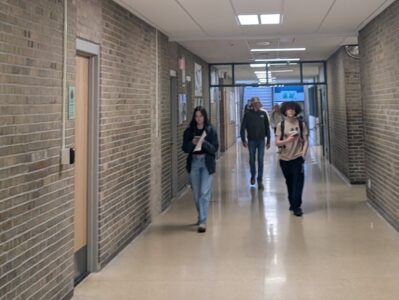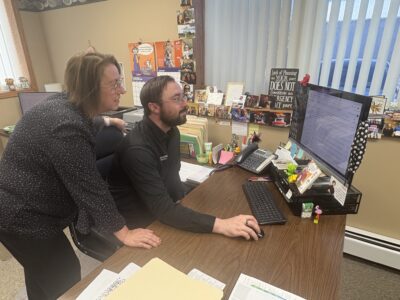Northeast Michigan school district response to COVID-19 and how attendance rates have changed

News Photo by Reagan Voetberg Students at Alpena High School walk to class on Monday afternoon.
ALPENA — School districts across the U.S. experienced low attendance rates and high chronic absenteeism rates during the COVID-19 pandemic. Since then, some districts have rebounded, while others are still working to get those rates back to pre-pandemic numbers.
Chronic absenteeism — defined as students missing 10% or more of school — emerged as a serious challenge during the COVID-19 pandemic, according to the U.S. Department of Education (DOE). The U.S. rate of chronic absenteeism reached about 31% in the 2021-2022 school year and decreased to 28% in the 2022-23 school year.
Chronic absence derives from multiple, often interconnected factors, according to the DOE. Research points to student disengagement, lack of access to student and family supports, and student and family health challenges as significant drivers.
In Northeast Michigan, Hillman Community Schools saw an increase in attendance rates in the 2020-2021 school year, the year where schools had to make difficult decisions about whether to have their students learn from home or in-person with safety precautions.
The next year, 2021-2022, attendance rates dropped significantly by about 4%, from 93.9% to 90.2%, according to attendance data from MI School Data. Since then, attendance rates at Hillman have climbed to 92.5% in 2024-2025, with only one year with a slight drop, from 91.2% in 2022-2023 to 91% in 2023-2024.
Hillman’s COVID response, Superintendent Pamela Rader said in an email, was to remain virtual at first. When students were allowed to return, they also provided online options for families that were concerned about sending their children back. Hybrid options were also offered so that each family could choose the path that best fit their needs.
Posen Consolidated School District also saw an attendance increase in the 2020-2021 school year, with an attendance rate of 95.3% in 2020-2021 from 93.5% in 2019-2020. The attendance rate dropped by about 2.5% to 92.8% in 2021-2022.
Posen Superintendent Michelle Wesner said that in the 2020-2021 school year, students were all attending classes in-person.
“In our community, our parents wanted our kids at school,” Wesner said.
Since the COVID years, Posen’s attendance rates have remained high, recording a nearly 94% attendance rate in 2024-2025. Chronic absenteeism rates had a dramatic increase in 2021-2022 to 27.2%, up 20% from the previous year. Now, Posen’s chronic absenteeism rates are about the same as pre-pandemic rates, which is out of the ordinary as many districts are struggling to rebound.
Hillman’s chronic absentee rates were around 15% pre-pandemic for instance, while the chronic absentee rates post-pandemic have hovered around 30%.
Alcona Community Schools saw a decrease in attendance rates in 2020-2021, from 94% in 2019-2020 to 82.5%. Additionally, 62% of students were chronically absent in 2020-2021, but significant progress has been made since, with 31.5% chronically absent in 2024-2025. Alcona High School was online for the first semester and in person the second semester, Superintendent Dan O’Connor said in a text.
Alpena Public Schools had a 91.7% attendance rate in 2020-2021, a decrease from 94.9% the previous school year. Attendance rates dropped off until 2024-2025, where the rate increased for the first time since COVID to 87.3% by about 2% from the 2023-2024 school year. APS has also not reached pre-pandemic chronic absentee rates, with 44.1% of students chronically absent in 2024-2025. Pre-pandemic, chronic absentee rates ranged from 11-15%.
According to reports from The News in 2020-2021, Alpena offered a mix of online and in-person classes for students. At a couple points in the school year, classes went completely online due to outbreaks of the COVID-19 virus. The last few weeks of school were in-person.
Reagan Voetberg can be reached at 989-358-5683 or rvoetberg@TheAlpenaNews.com.



